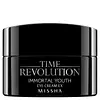What's inside
What's inside
 Key Ingredients
Key Ingredients

 Benefits
Benefits

 Concerns
Concerns

 Ingredients Side-by-side
Ingredients Side-by-side

Water
Skin ConditioningCaprylic/Capric Triglyceride
MaskingCetearyl Alcohol
EmollientGlycerin
HumectantSnail Secretion Filtrate
Skin ConditioningPropanediol
SolventNiacinamide
SmoothingCyclopentasiloxane
EmollientCyclohexasiloxane
Emollient1,2-Hexanediol
Skin ConditioningGlyceryl Stearate
EmollientPEG-100 Stearate
Polyacrylate-13
Butylene Glycol
HumectantSorbitan Stearate
EmulsifyingPolyisobutene
Palmitic Acid
EmollientDioscorea Japonica Root Extract
Skin ConditioningStearic Acid
CleansingEthylhexylglycerin
Skin ConditioningBeta-Glucan
Skin ConditioningHydrolyzed Corn Starch
HumectantPolysorbate 20
EmulsifyingSorbitan Isostearate
EmulsifyingAdenosine
Skin ConditioningSucrose
HumectantDisodium EDTA
Sodium Hyaluronate
HumectantSodium Chondroitin Sulfate
Skin ConditioningOriganum Vulgare Leaf Extract
Skin ConditioningChamaecyparis Obtusa Leaf Extract
Skin ConditioningSalix Alba Bark Extract
AstringentLactobacillus/Soybean Ferment Extract
Skin ConditioningPortulaca Oleracea Extract
Skin ConditioningCinnamomum Cassia Bark Extract
MaskingScutellaria Baicalensis Root Extract
AstringentPhenoxyethanol
PreservativeParfum
MaskingWater, Caprylic/Capric Triglyceride, Cetearyl Alcohol, Glycerin, Snail Secretion Filtrate, Propanediol, Niacinamide, Cyclopentasiloxane, Cyclohexasiloxane, 1,2-Hexanediol, Glyceryl Stearate, PEG-100 Stearate, Polyacrylate-13, Butylene Glycol, Sorbitan Stearate, Polyisobutene, Palmitic Acid, Dioscorea Japonica Root Extract, Stearic Acid, Ethylhexylglycerin, Beta-Glucan, Hydrolyzed Corn Starch, Polysorbate 20, Sorbitan Isostearate, Adenosine, Sucrose, Disodium EDTA, Sodium Hyaluronate, Sodium Chondroitin Sulfate, Origanum Vulgare Leaf Extract, Chamaecyparis Obtusa Leaf Extract, Salix Alba Bark Extract, Lactobacillus/Soybean Ferment Extract, Portulaca Oleracea Extract, Cinnamomum Cassia Bark Extract, Scutellaria Baicalensis Root Extract, Phenoxyethanol, Parfum
Betula Alba Juice
AstringentCyclomethicone
EmollientDimethicone/Vinyl Dimethicone Crosspolymer
Skin ConditioningGlycerin
HumectantButylene Glycol
HumectantDipropylene Glycol
HumectantNiacinamide
SmoothingSilica
Abrasive1,2-Hexanediol
Skin ConditioningAcetyl Tetrapeptide-5
HumectantSh-Decapeptide-9
Skin ConditioningSodium Cocoyl Alaninate
Dimethicone
EmollientHydrogenated Lecithin
EmulsifyingCassia Alata Leaf Extract
AstringentAdenosine
Skin ConditioningHydrolyzed Myrtus Communis Leaf Extract
Skin ProtectingResveratrol
AntioxidantXanthophylls
Skin ConditioningAlgin
MaskingPolyglutamic Acid
Skin ConditioningTitanium Dioxide
Cosmetic ColorantPhenoxyethanol
PreservativeBetula Alba Juice, Cyclomethicone, Dimethicone/Vinyl Dimethicone Crosspolymer, Glycerin, Butylene Glycol, Dipropylene Glycol, Niacinamide, Silica, 1,2-Hexanediol, Acetyl Tetrapeptide-5, Sh-Decapeptide-9, Sodium Cocoyl Alaninate, Dimethicone, Hydrogenated Lecithin, Cassia Alata Leaf Extract, Adenosine, Hydrolyzed Myrtus Communis Leaf Extract, Resveratrol, Xanthophylls, Algin, Polyglutamic Acid, Titanium Dioxide, Phenoxyethanol
Ingredients Explained
These ingredients are found in both products.
Ingredients higher up in an ingredient list are typically present in a larger amount.
1,2-Hexanediol is a synthetic liquid and another multi-functional powerhouse.
It is a:
- Humectant, drawing moisture into the skin
- Emollient, helping to soften skin
- Solvent, dispersing and stabilizing formulas
- Preservative booster, enhancing the antimicrobial activity of other preservatives
Adenosine is in every living organism. It is one of four components in nucleic acids that helps store our DNA.
Adenosine has many benefits when used. These benefits include hydrating the skin, smoothing skin, and reducing wrinkles. Once applied, adenosine increases collagen production. It also helps with improving firmness and tissue repair.
Studies have found adenosine may also help with wound healing.
In skincare products, Adenosine is usually derived from yeast.
Learn more about AdenosineButylene Glycol (or BG) is used within cosmetic products for a few different reasons:
Overall, Butylene Glycol is a safe and well-rounded ingredient that works well with other ingredients.
Though this ingredient works well with most skin types, some people with sensitive skin may experience a reaction such as allergic rashes, closed comedones, or itchiness.
Learn more about Butylene GlycolGlycerin is already naturally found in your skin. It helps moisturize and protect your skin.
A study from 2016 found glycerin to be more effective as a humectant than AHAs and hyaluronic acid.
As a humectant, it helps the skin stay hydrated by pulling moisture to your skin. The low molecular weight of glycerin allows it to pull moisture into the deeper layers of your skin.
Hydrated skin improves your skin barrier; Your skin barrier helps protect against irritants and bacteria.
Glycerin has also been found to have antimicrobial and antiviral properties. Due to these properties, glycerin is often used in wound and burn treatments.
In cosmetics, glycerin is usually derived from plants such as soybean or palm. However, it can also be sourced from animals, such as tallow or animal fat.
This ingredient is organic, colorless, odorless, and non-toxic.
Glycerin is the name for this ingredient in American English. British English uses Glycerol/Glycerine.
Learn more about GlycerinNiacinamide is a multitasking form of vitamin B3 that strengthens the skin barrier, reduces pores and dark spots, regulates oil, and improves signs of aging.
And the best part? It's gentle and well-tolerated by most skin types, including sensitive and reactive skin.
You might have heard of "niacin flush", or the reddening of skin that causes itchiness. Niacinamide has not been found to cause this.
In very rare cases, some individuals may not be able to tolerate niacinamide at all or experience an allergic reaction to it.
If you are experiencing flaking, irritation, and dryness with this ingredient, be sure to double check all your products as this ingredient can be found in all categories of skincare.
When incorporating niacinamide into your routine, look out for concentration amounts. Typically, 5% niacinamide provides benefits such as fading dark spots. However, if you have sensitive skin, it is better to begin with a smaller concentration.
When you apply niacinamide to your skin, your body converts it into nicotinamide adenine dinucleotide (NAD). NAD is an essential coenzyme that is already found in your cells as "fuel" and powers countless biological processes.
In your skin, NAD helps repair cell damage, produce new healthy cells, support collagen production, strengthen the skin barrier, and fight environmental stressors (like UV and pollution).
Our natural NAD levels start to decline with age, leading to slower skin repair, visible aging, and a weaker skin barrier. By providing your skin niacinamide, you're recharging your skin's NAD levels. This leads to stronger, healthier, and younger looking skin.
Another name for vitamin B3 is nicotinamide. This vitamin is water-soluble and our bodies don't store it. We obtain Vitamin B3 from either food or skincare. Meat, fish, wheat, yeast, and leafy greens contain vitamin B3.
The type of niacinamide used in skincare is synthetically created.
Learn more about NiacinamidePhenoxyethanol is a preservative that has germicide, antimicrobial, and aromatic properties. Studies show that phenoxyethanol can prevent microbial growth. By itself, it has a scent that is similar to that of a rose.
It's often used in formulations along with Caprylyl Glycol to preserve the shelf life of products.